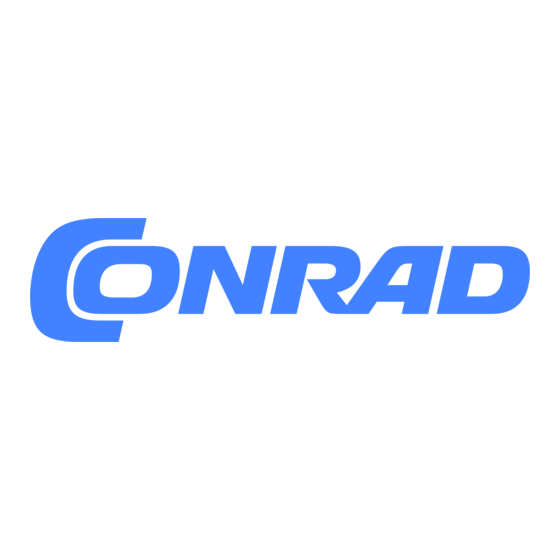
Werbung
Quicklinks
B E D I E N U N G S A N L E I T U N G
USB3.0/eSATA-Anschlusskabel
Best.-Nr. 97 51 66
Bestimmungsgemäße Verwendung
Über das Anschlusskabel lässt sich ein externes Festplatten-/Laufwerksgehäuse mit eSATA-
Anschluss an einem USB3.0-Port (oder USB2.0/1.1) eines Computers betreiben.
Das externe Festplatten-/Laufwerksgehäuse muss über eine eigene Stromversorgung verfügen.
Dieses Produkt erfüllt die gesetzlichen, nationalen und europäischen Anforderungen. Alle ent-
haltenen Firmennamen und Produktbezeichnungen sind Warenzeichen der jeweiligen Inhaber.
Alle Rechte vorbehalten.
Lieferumfang
• Anschlusskabel
• Bedienungsanleitung
Anschluss
• Verbinden Sie den eSATA-Stecker des Anschlusskabels mit dem externen Festplatten/
Laufwerksgehäuse.
• Schalten Sie das Festplatten-/Laufwerksgehäuse ein.
• Verbinden Sie den USB-Stecker mit einem freien USB3.0-Port Ihres Computers.
Wenn Ihr Computer noch keinen USB3.0-Port hat, so kann selbstverständlich auch
ein USB2.0/1.1-Port verwendet werden. Die Geschwindigkeit der Datenübertragung
ist hier entsprechend geringer.
• Das Betriebssystem erkennt neue Hardware und installiert die Treiber (im Betriebssystem ent-
halten).
Anschließend steht das externe Festplatten-/Laufwerksgehäuse zur Verfügung.
Wenn Sie ein externes Festplattengehäuse verwenden, in dem Sie eine neue
Festplatte eingebaut haben, so muss diese neue Festplatte zuerst partitioniert und
formatiert werden, bevor Daten darauf gespeichert werden können.
Unter Windows ist die Partitionierung und anschließende Formatierung in der
Computerverwaltung möglich.
Tipps und Hinweise
• Eine LED auf dem Anschlusskabel dient als Power-LED (die LED leuchtet dauernd) bzw.
Lese-/Schreibzugriffe auf das externe Festplatten-/Laufwerksgehäuse an (LED blinkt).
• Das externe Festplatten-/Laufwerksgehäuse muss über eine eigene Stromversorgung verfügen.
• Anstelle eines USB3.0-Ports kann auch ein herkömmlicher USB2.0/1.1-Port zum Anschluss
des Adapters verwendet werden.
Entsorgung
Elektrische und elektronische Produkte dürfen nicht in den Hausmüll!
Entsorgen Sie das Produkt am Ende seiner Lebensdauer gemäß den geltenden
gesetzlichen Bestimmungen.
Technische Daten
USB-Standard: ....................................USB3.0 (kompatibel zu USB2.0/1.1)
Kabellänge: ..........................................ca. 1.3 m
Diese Bedienungsanleitung ist eine Publikation der Conrad Electronic SE, Klaus-Conrad-Str. 1,
D-92240 Hirschau (www.conrad.com).
Alle Rechte einschließlich Übersetzung vorbehalten. Reproduktionen jeder Art, z. B. Fotokopie,
Mikroverfilmung, oder die Erfassung in elektronischen Datenverarbeitungsanlagen, bedürfen der
schriftlichen Genehmigung des Herausgebers. Nachdruck, auch auszugsweise, verboten.
Diese Bedienungsanleitung entspricht dem technischen Stand bei Drucklegung. Änderung in Technik
und Ausstattung vorbehalten.
© Copyright 2010 by Conrad Electronic SE.
www.conrad.com
Version 12/10
USB 3.0/eSATA Connection Cable
°
Item-No. 97 51 66
Intended Use
This connection cable enables an external hard disk or drive enclosure with an eSATA connec-
tion to be connected to a USB 3.0 (or USB 2.0/1.1) port on a computer.
The external hard disk or drive enclosure must have its own power supply.
This product complies with the applicable National and European requirements. All names of
companies and products are the trademarks of the respective owner. All rights reserved.
Package Contents
• Connection cable
• Operating Instructions
Connection
• Connect the eSATA jack on the connection cable with the external hard disk or
drive enclosure.
• Turn on the hard disk or drive enclosure.
• Connect the USB plug to a free USB 3.0 port on your computer.
• The operating system will detect the new hardware and install the driver (already included in
the operating system).
The external hard disk or drive enclosure is then available for use.
Tips and Notes
• An LED on the connection cable serves as both a power LED (the LED remains lit steadily) as
well as to indicate read/write access on the external hard disk or drive enclosure (LED blinks).
• The external hard disk or drive enclosure must have its own power supply.
• Instead of a USB 3.0 port, a USB 2.0/1.1 port, where available, can also be used to connect
the adapter.
Disposal
Technical Data
USB standard: ......................................USB 3.0 (compatible with USB 2.0/1.1)
Cable length: ........................................approx. 1.3 m
© Copyright 2010 by Conrad Electronic SE.
O P E R A T I N G I N S T R U C T I O N S
If no USB 3.0 port is available, it is of course OK to use a USB 2.0/1.1 port instead.
In which case, the speed of the data transfer is accordingly slower.
If you are using an external hard disk enclosure in which you have installed a new
hard disk, this new drive must be partitioned first and formatted before data can be
saved to it.
In Windows, the partitioning and subsequent formatting can be done from the com-
puter administrator profile.
Electrical and electronic products do not belong in the household waste!!
Please dispose of the device when it is no longer of use, according to the current
statutory requirements.
These operating instructions are a publication by Conrad Electronic SE, Klaus-Conrad-Str. 1, D-92240
Hirschau (www.conrad.com).
All rights including translation reserved. Reproduction by any method, e.g. photocopy, microfilming, or
the capture in electronic data processing systems require the prior written approval by the editor.
Reprinting, also in part, is prohibited.
These operating instructions represent the technical status at the time of printing. Changes in
technology and equipment reserved.
www.conrad.com
Version 12/10
°
Werbung

Inhaltszusammenfassung für Conrad USB 3.0/eSATA
- Seite 1 USB-Standard: ........USB3.0 (kompatibel zu USB2.0/1.1) Kabellänge: ..........ca. 1.3 m Diese Bedienungsanleitung ist eine Publikation der Conrad Electronic SE, Klaus-Conrad-Str. 1, These operating instructions are a publication by Conrad Electronic SE, Klaus-Conrad-Str. 1, D-92240 D-92240 Hirschau (www.conrad.com). Hirschau (www.conrad.com). Alle Rechte einschließlich Übersetzung vorbehalten. Reproduktionen jeder Art, z. B. Fotokopie, All rights including translation reserved.
- Seite 2 USB standard : ........USB3.0 (compatible avec USB2.0/1.1) Kabellengte:..........ca. 1,3 m Longueur de câble :......env. 1,3 m Ce mode d'emploi est une publication de la société Conrad Electronic SE, Klaus-Conrad-Str. 1, Deze gebruiksaanwijzing is een publicatie van de firma Conrad Electronic SE, Klaus-Conrad-Str. 1, D-92240 Hirschau (www.conrad.com).

